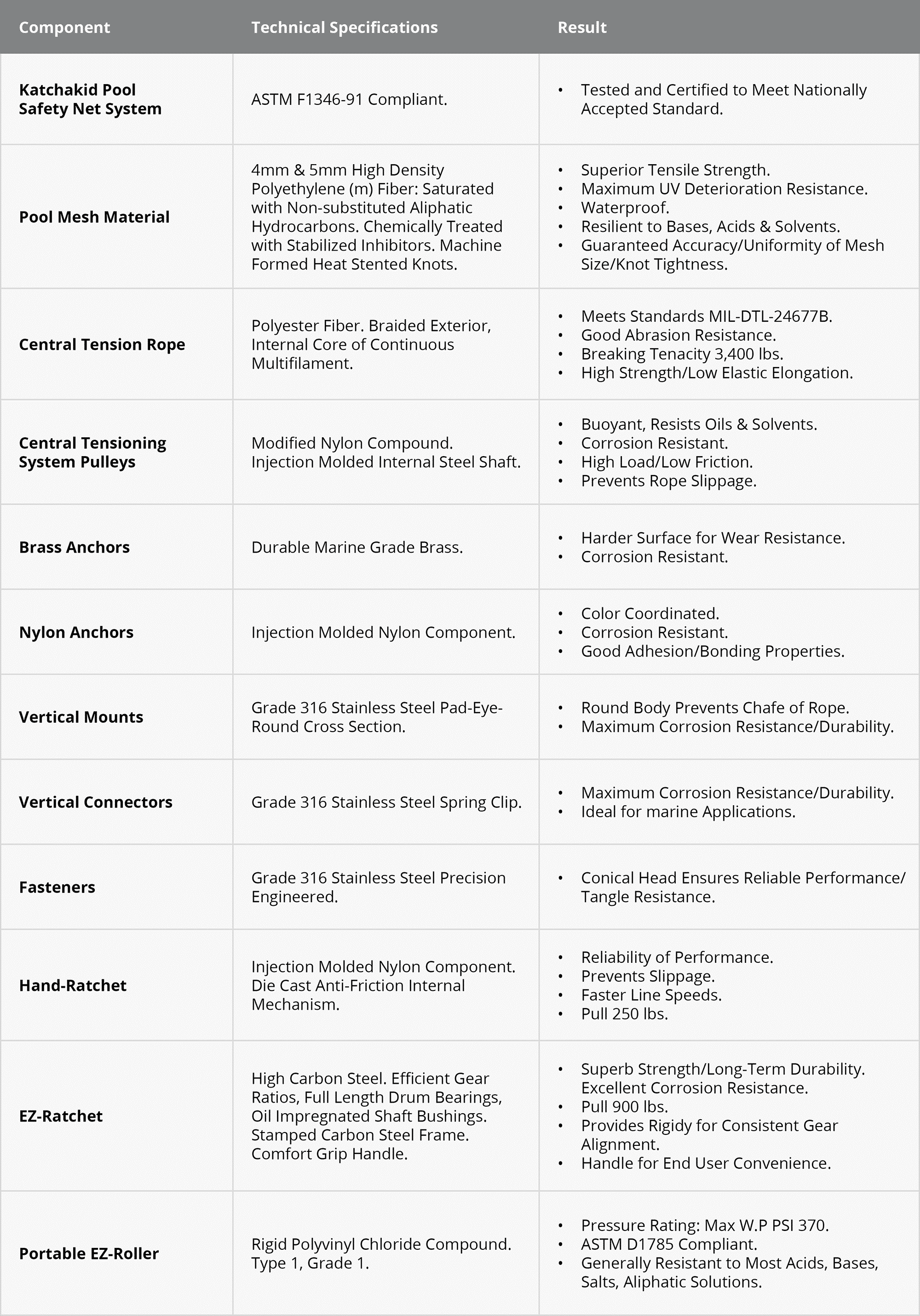Updated California Pool Safety Act Requires Pool Owners to Double Up Safety Measures
California Pool Owners – As of January 1, 2018, pool owners will need to install at least 2 of 7 specified drowning prevention safety features to reduce the serious risk of drowning. (Even if you’re not a California pool owner, keep reading—at Katchakid, we believe these pool safety standards are excellent guidelines to apply to any pool, anywhere.)
Children and Pools: The Risks and Stats
Pools may be a great way to beat the California heat, but they come with inherent safety risks to children. Sadly, drowning is the second-leading cause of death for 1 to 4-year-old children in California. A tragic 160 young children died from drowning in California pools between 2010 and 2014, and in this period more than 740 children were hospitalized for near-fatal drowning injuries including brain trauma caused by near drowning.
The California Pool Safety Act’s History
California’s original 1996 Pool Safety Act required all new private swimming pools to be equipped with at least one approved safety measure; a permanent fence, compliant pool cover, door & window alarms, and self-closing door and window devices. This California pool law was amended in 2006 to include two more pool safety barriers – an ASTM F 2286-05 compliant removable mesh pool fence and an ASTM F 2208-08 pool alarm. This recent 2018 amendment now requires newly permitted private pools to double up security measures by requiring the pool to be equipped with 2 out of 7 choices of compliant separate safety features.
How to Comply with the New California Law Pool Safety Regulations
During the planning process of building your new pool or remodeling your existing one, take the time to research which of the two approved safety measures will work best for your pool layout and family’s security.
The Updated Pool Safety Measures
As of January 1, 2018, newly permitted California pool owners will need to install at least TWO of the following safety measures with any new or remodeled pool:
(1) An enclosure that meets the requirements of Section 115923 and isolates the swimming pool or spa from the private single-family home. An “Enclosure” means a fence, wall, or another barrier that isolates a swimming pool from access to the home. Compliance with this section includes, but is not limited to, the following:
- Any access gates through the enclosure must open away from the swimming pool, and must be self-closing with a self-latching device placed no lower than 60 inches above the ground.
- The enclosure must be a minimum height of 60 inches.
- The maximum vertical clearance from the ground to the bottom of the enclosure shall be no more than 2 inches.
- Any gaps or voids in the enclosure shall not allow passage of a sphere equal to or greater than 4 inches.
- The outside surface shall be free of protrusions, cavities, or other physical characteristics that would serve as handholds or footholds that could enable a child below the age of five years to climb over the enclosure.
- The enclosure shall isolate the swimming pool or spa from the private single-family home. [Health and Safety Code 511922 (a)(1)]
(2) A removable mesh fencing that meets American Society for Testing and Materials (ASTM) Specifications F2286 standards in conjunction with a gate that is self-closing and self-latching and can accommodate a key lockable device. Compliance with this code includes, but is not limited to, the following:
- The top of a fence or wall used as a barrier needs to be a minimum of 48 inches above the exterior side of the barrier.
- The access gate opens away from the swimming pool.
- There will be a clear zone of at least 20 inches between the barrier and swimming pool.
- The gate is self-closing, and self-latching and the latch is placed no lower than 54-inches above the ground. The gate is hinged, and the latch is placed on the outside of the gate.
- The fence height on both sides of the grade will be above 48 inches.
- The vertical clearance from the grade to the enclosure bottom will not exceed 1 inch.
- Gaps and Voids within the fence will not allow passage of a sphere equal or greater to 4 inches.
- The fence surface will be free of protrusions, cavities and other characteristics that would serve as a handhold or foothold. The distance between the vertical poles is sufficient to hinder a child’s ability to climb.
(3) An approved safety pool cover, as defined in subdivision (d) of Section 115921. This is an ASTM F1346-91 compliant automatic or manual pool cover. Compliance with this code includes, but is not limited to, the following:
- The static load test for weight support. The cover should be able to hold a weight of at least 485lbs (the estimated average weight of 2 adults and one child) to permit rescue operation.
- Perimeter Deflection Tests for entry or entrapment between the cover and the side of the pool. The cover must demonstrate that any opening is sufficiently small and strong enough to prevent the test object being passed through.
- The Surface Drainage Test that safeguards against a dangerous amount of water collecting on the cover’s surface.
- Labeling requirements must include basic consumer information such as the warranty information, the appropriate warnings as described in the standard and acknowledge the product as a safety cover.
(4) Exit alarms on the private single-family home’s doors that provide direct access to the swimming pool or spa. The exit alarm may cause either an alarm noise or a verbal warning, such as a repeating notification that “the door to the pool is open.” Exit alarms are also required on ANY door or window that permits access from the residence to the pool area without an enclosure between the pool and the home. The exit alarm must make a continuous audible sound when the door or window is open and or ajar.
(5) A self-closing, self-latching device with a release mechanism placed no lower than 54 inches above the floor on the private single-family home’s doors providing direct access to the swimming pool or spa; this is ANY door opening on to the pool area, sliding or otherwise.
(6) An alarm that, when placed in a swimming pool or spa, will sound upon detection of accidental or unauthorized entrance into the water. The alarm shall meet and be independently certified to the ASTM Standard F2208 “Standard Safety Specification for Residential Pool Alarms,” which includes surface motion, pressure, sonar, laser, and infrared type alarms. A swimming protection alarm feature designed for individual use, including an alarm attached to a child that sounds when the child exceeds a certain distance or becomes submerged in water, is not a qualifying drowning prevention safety feature. Compliance with this code includes, but is not limited to, the following:
- The alarm shall sound within 20 seconds both at the pool and within the residence via a remote receiver.
- The operational condition of the alarm shall be made known by means of an energized lamp at a distance of 10 feet +/- 1 foot and specified at a specified angle of view (45 degrees from perpendicular +/- % degrees).
- The alarm shall be capable of providing a sound pressure level of not less than 85 DBA.
- If the alarm is battery operated, there must be a low-battery indicator.
- The alarm must automatically reset.
- Wireless alarms must be FCC Part-15 compliant.
- If the alarm deactivates or has reduced sensitivity due to environmental factors, the alarm must provide a visual and audible warning.
(7) Other means of protection, if the degree of protection afforded is equal to or greater than that afforded by any of the features set forth above and has been independently verified by an approved testing laboratory as meeting standards for those features established by the ASTM or the American Society of Mechanical Engineers (ASME).
(Source: California Senate Bill 442)
How Katchakid Can Help
If you install a Katchakid pool fence and Katchakid pool net, your pool will comply with two of the choices of compliant separate safety features, and you’ll gain peace of mind knowing you have installed two effective drowning preventative layers. As Senator Newman said, “Residential California pool drownings can be prevented, and SB 442 will go far toward reducing the pain and costs associated with pool drownings.”
Katchakid has decades of experience in helping pool owners make their pools safe. Our safety technicians are here to answer any questions you may have, and they go through intensive training to learn how to install our products for the utmost safety and reliability. Contact us to learn more about our pool fences, pool covers, and pool nets today!






